We’ve all walked past houses that make us stop and stare – and more often than not it’s the stunning front yard plantings that catch our eye. The right plants in front of your house don’t just boost curb appeal; they create an inviting entrance that reflects your personality and increases your home’s value.
Choosing the perfect front yard plants isn’t just about picking pretty flowers. We need to consider factors like your home’s architectural style, local climate, maintenance requirements, and how different plants work together to create year-round interest. Whether you’re working with a small entryway or a sprawling front industry, the key is selecting plants that thrive in your exact conditions while creating the look you want.
From classic foundation plantings to bold statement gardens, we’ll explore proven strategies that transform ordinary front yards into neighborhood showstoppers. Let’s jump into creating a front yard that welcomes guests and makes you proud to come home.
Choose Low-Maintenance Foundation Plants for Year-Round Appeal
We’ve found that foundation plants serve as the backbone of front yard landscaping, providing consistent visual interest without demanding constant attention from busy homeowners.
Evergreen Shrubs for Consistent Structure
Boxwood varieties create timeless elegance around your home’s foundation with their dense, compact growth habit. We recommend English boxwood (Buxus sempervirens) for formal landscapes and Japanese boxwood (Buxus microphylla) for smaller spaces. These shrubs maintain their rich green color throughout winter and require minimal pruning once established.
Juniper cultivars offer incredible versatility with options ranging from low-spreading varieties to upright columnar forms. Blue Star juniper stays compact at 2-3 feet tall, while Skyrocket juniper can reach 15-20 feet for dramatic vertical accents. Their needle-like foliage provides texture contrast against your home’s siding or stone.
Rhododendrons and azaleas deliver spectacular spring blooms while maintaining attractive foliage year-round. We suggest choosing compact varieties like ‘PJM’ rhododendrons or ‘Encore’ azaleas that bloom twice annually. These acid-loving plants thrive in partial shade and create stunning focal points near entryways.
Drought-Tolerant Perennials for Easy Care
Ornamental grasses bring movement and seasonal interest to foundation plantings without requiring frequent watering. Feather reed grass (Calamagrostis x acutiflora) grows in neat clumps and produces attractive seed heads in late summer. Little bluestem (Schizachyrium scoparium) offers bronze and orange fall colors that complement autumn landscapes.
Sedums and succulents store water in their fleshy leaves, making them perfect for hot, dry locations around your home’s foundation. Autumn Joy sedum produces pink flowers that transition to rust-colored seed heads, while Dragon’s Blood sedum creates a dense carpet of red-tinged foliage. These plants require almost no maintenance once established.
Lavender varieties combine drought tolerance with fragrant blooms that attract beneficial pollinators to your front yard. English lavender (Lavandula angustifolia) works well in cooler climates, while Spanish lavender (Lavandula stoechas) thrives in warmer regions. We recommend planting lavender near walkways where visitors can enjoy its aromatic qualities.
Native Plants for Natural Beauty
Regional wildflowers adapt naturally to local soil and climate conditions, reducing the need for fertilizers and supplemental watering. Purple coneflower (Echinacea purpurea) attracts butterflies and birds while providing long-lasting summer blooms. Black-eyed Susan (Rudbeckia fulgida) creates cheerful yellow displays that persist into fall.
Indigenous shrubs support local wildlife while requiring minimal care from homeowners. Serviceberry (Amelanchier canadensis) produces spring flowers, summer berries, and brilliant fall foliage. Spicebush (Lindera benzoin) thrives in shade and offers yellow autumn color plus berries for migrating birds.
Native ferns excel in shaded foundation areas where many other plants struggle to grow. Christmas fern (Polystichum acrostichoides) stays green throughout winter, while royal fern (Osmunda regalis) creates dramatic texture with its large fronds. These ancient plants require no fertilization and thrive with minimal water once established.
Create Visual Interest with Layered Heights and Textures
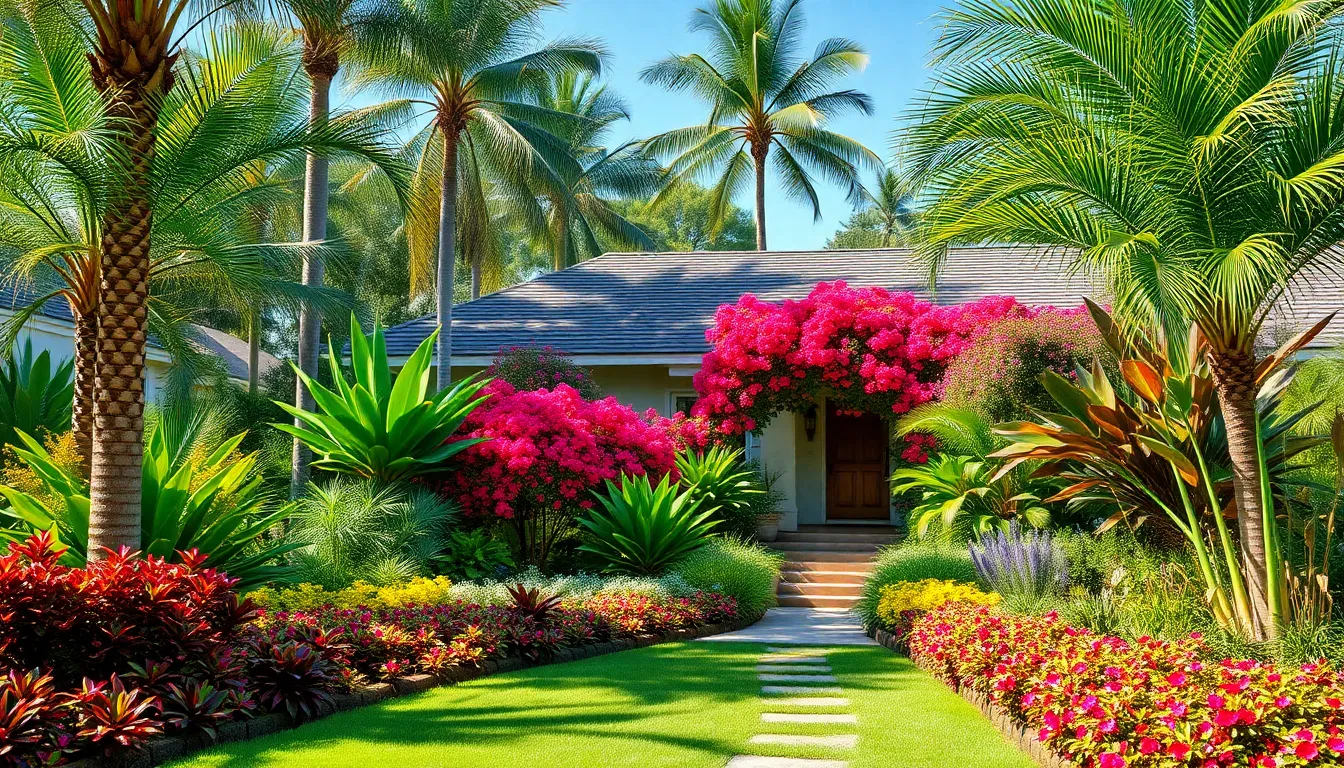
Layering plants creates depth and visual richness that transforms our front yards from flat landscapes into ever-changing garden spaces. We combine bold textured foliage with finer textures to avoid a messy appearance while establishing structure and variety throughout our plantings.
Tall Backdrop Plants for Privacy and Drama
Tall plants serve as the backbone of our layered design by providing privacy and creating dramatic vertical interest. We use trees or tall shrubs to frame our front yards and block unwanted views from neighbors or busy streets. Examples like tall palms or large leaf tropical plants add verticality and lushness in tropical climates. Native tall grasses and bold textured plants such as compass plant or prairie dock work exceptionally well for creating structure in native landscapes. These towering specimens establish the outer boundaries of our design while setting the stage for shorter plantings in front.
Medium-Height Focal Point Plants
Medium height plants act as the stars of our front yard show by drawing attention and anchoring the overall design. We position bold textured flowering plants and shrubs at eye level to create visual interest where visitors naturally look first. Developing a clear focal point using a striking plant, sculpture, or garden structure like an arbor helps organize our front yard landscaping with intentional emphasis. These middle layer plants bridge the gap between our tall backdrop specimens and low growing ground covers. We select flowering shrubs or ornamental plants that complement our home’s architecture while providing seasonal color and texture changes.
Ground Cover Plants for Finishing Touches
Low growing ground cover plants complete our layered approach by filling gaps, preventing weeds, and softening harsh hardscape edges. We rely on native grasses with dense fibrous roots for excellent weed control and maintaining overall garden health. Ground covers unify our entire design by adding color or texture contrast at the base layer where all other plantings meet the soil. These finishing plants create smooth transitions between different garden areas while reducing maintenance needs. We choose spreading perennials or dense mat forming plants that naturally suppress weeds and require minimal ongoing care once established.
Select Plants That Complement Your Home’s Architectural Style
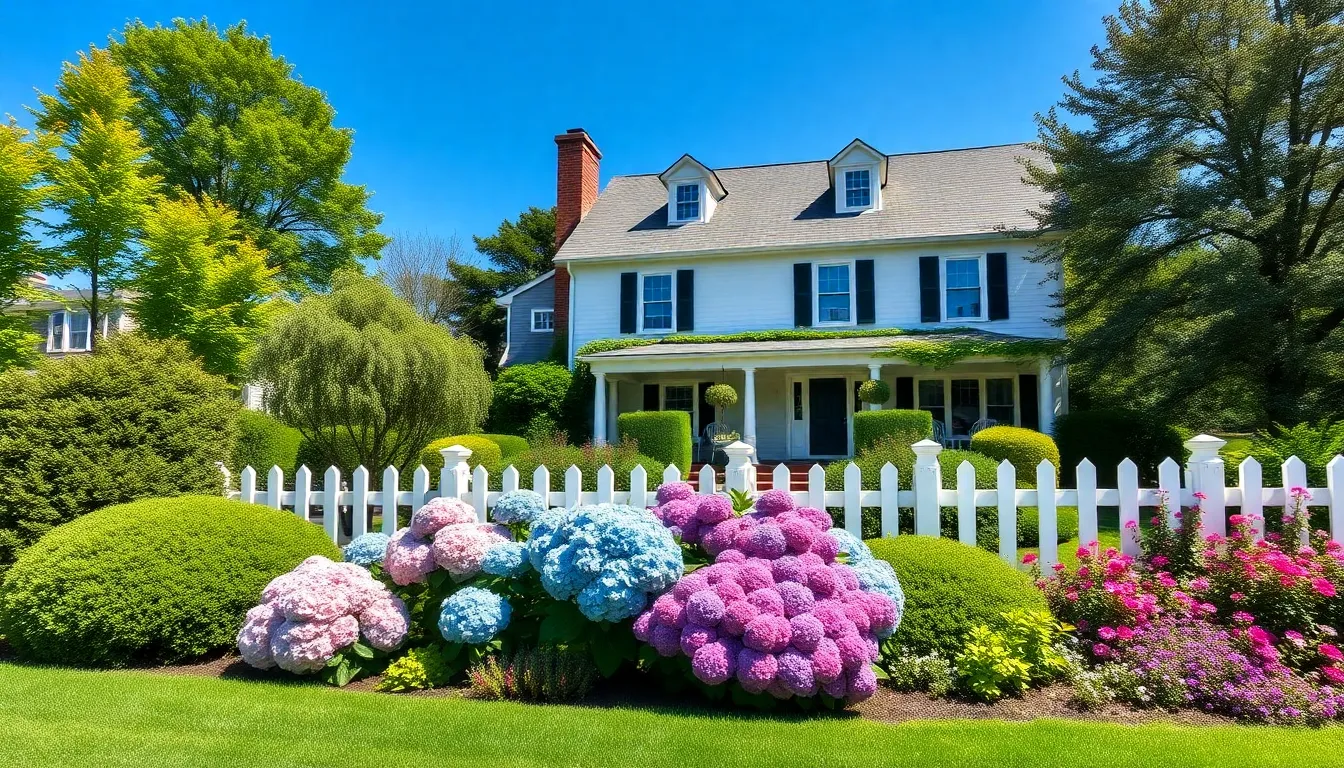
Choosing plants that harmonize with your home’s architectural design creates a cohesive and polished industry. We’ll explore how different home styles call for distinct plant selections that enhance their unique character.
Traditional Colonial Home Plant Choices
Colonial homes with their symmetrical facades benefit from formal, structured plantings that mirror their classic proportions. Boxwoods serve as the foundation of this timeless approach, offering year round structure that we can shape and maintain easily. Shamrock Holly provides an excellent alternative to traditional boxwoods while delivering the same crisp, manicured appearance.
Flowering shrubs add seasonal color without disrupting the formal aesthetic we’re creating. Hydrangeas bring spectacular summer blooms in shades of blue, pink, or white depending on soil conditions. Spirea offers delicate spring flowers and maintains an elegant form throughout the growing season.
Trees with classic shapes frame Colonial entrances beautifully and establish the formal tone. We recommend selecting specimens with symmetrical crowns that won’t overpower the home’s balanced proportions.
Modern Contemporary Home Landscaping
Contemporary homes demand bold, architectural plants that emphasize clean lines and striking forms. Agaves, particularly Parry’s Agave, create sculptural focal points with their geometric rosette shapes and dramatic presence. These succulents thrive in full sun and well drained soil while requiring minimal maintenance.
Fatsia japonica brings bold foliage drama to shaded areas with its large, uniquely shaped leaves. This versatile plant suits Asian inspired modern designs and adds textural interest without competing with the home’s clean architecture.
Grasses and evergreens with strong geometric forms complete the modern aesthetic we’re building. Upright ornamental grasses provide movement and seasonal interest. Spherical shrubs and succulents with sharp edges reinforce the sleek contemporary look.
Mid century modern homes specifically benefit from plants that offer clean layering without overwhelming the structure. Garden Glow Dogwood features chartreuse foliage that transforms to brilliant red in fall. Double Play Blue Kazoo Spirea combines unusual blue foliage with crisp white flowers. Compact evergreens like Hetz Mini Arborvitae and Nova Yew provide year round structure while maintaining appropriate scale.
Cottage Style Garden Plants
Cottage gardens embrace informal, lush plantings that create a welcoming, relaxed atmosphere. Flowering perennials form the backbone of this romantic style, with lavender providing fragrant purple spikes and silvery foliage. Foxglove adds dramatic vertical interest with its towering flower spikes in various colors. Hollyhocks create cottage garden charm with their old fashioned blooms reaching impressive heights.
Mixed shrubs interspersed with climbing vines establish the layered, abundant look we associate with cottage style. Rosa rugosa or other fragrant roses climb trellises and arbors while providing seasonal blooms and attractive hips.
Plants with softer, rounded forms and abundant blooms complete the cottage garden aesthetic. Herbaceous borders filled with delphiniums, peonies, and catmint create the overflowing abundance that makes cottage gardens so inviting and distinctive.
Plan for Seasonal Color and Continuous Blooms
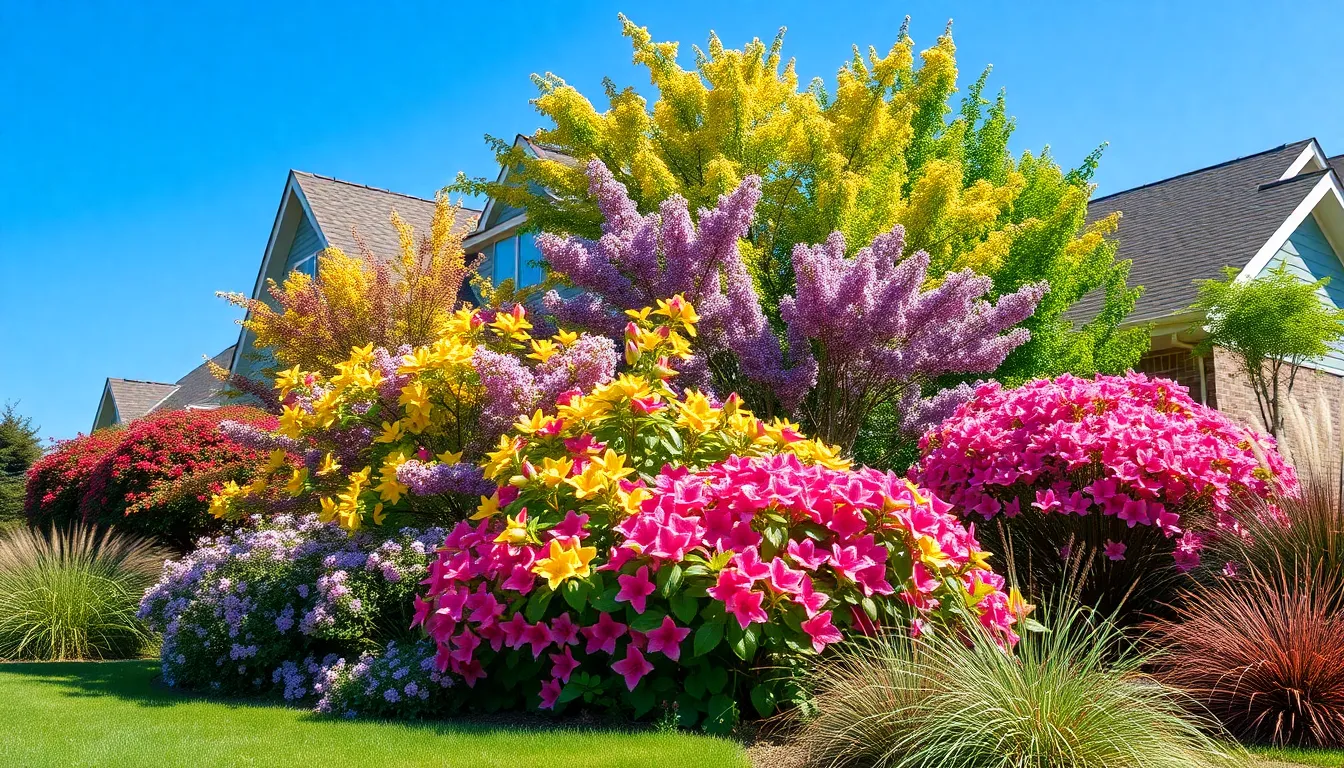
Creating a front yard that maintains visual appeal throughout the year requires strategic plant selection that delivers sequential blooms across all seasons. We’ll combine early spring flowering shrubs with summer bloomers and plants that provide fall and winter interest to ensure our industry never looks dormant.
Spring Flowering Plants for Early Season Impact
Forsythia leads our spring lineup with its spectacular display of bright yellow flowers that bloom along graceful arching branches in early spring. This fast growing shrub thrives in full sun and attracts bees and butterflies while providing crucial early season pollinator support. We recommend planting forsythia in fall for the best establishment, as it’s both low maintenance and drought tolerant once established.
Lilac brings classic charm to spring landscapes with its fragrant purple flower clusters that bloom in mid spring. These hardy shrubs prefer full to partial sun and develop excellent drought tolerance over time. Lilacs create that coveted cottage garden atmosphere while requiring minimal care once they’re established in the industry.
Azaleas deliver blazing color through their trumpet shaped flowers in vibrant pink and other eye catching hues during spring months. We plant these showstoppers in partial shade locations where they excel as hedge plants or stunning container specimens. Remember that azaleas are toxic to both pets and humans if ingested, so placement requires careful consideration.
Hydrangeas provide versatile spring to summer blooms with their large colorful flower heads in soft blue, pink, or white tones. These popular shrubs adapt well to part shade or full sun conditions and work beautifully as focal points or foundation plants in our front yard designs.
Summer Blooming Plants for Peak Season
Potentilla maintains vibrant summer color with its cheerful yellow to orange five petaled flowers that bloom consistently through the hottest months. This hardy shrub thrives in part to full sun locations while demonstrating excellent drought tolerance and natural deer resistance. We value potentilla for its low maintenance requirements and sustained curb appeal during summer’s peak growing season.
Complementary plantings enhance summer displays when we add carefully selected annuals or perennials that peak during these warmer months. Ornamental grasses and strategic filler plants maintain essential texture and greenery even when individual flowers fade, creating a cohesive summer industry.
Fall and Winter Interest Plants
Evergreen shrubs provide year round structure through plants like certain azalea varieties and camellias that retain their attractive foliage during winter months. These plants form the backbone of our seasonal design, ensuring the front yard maintains visual weight and greenery when deciduous plants go dormant.
Ornamental grasses and ivy add textural interest during the quieter fall and winter seasons when most flowering plants have finished their displays. We strategically place these plants to create movement and visual appeal throughout the colder months.
Late blooming hardy plants extend our color season into fall and even mild winter periods, ensuring our front yard industry transitions gracefully between seasons. This balanced approach guarantees continuous color from spring’s first blooms through winter’s serene greenery, maximizing both curb appeal and home value year round.
Consider Practical Factors When Choosing Plants in Front of House
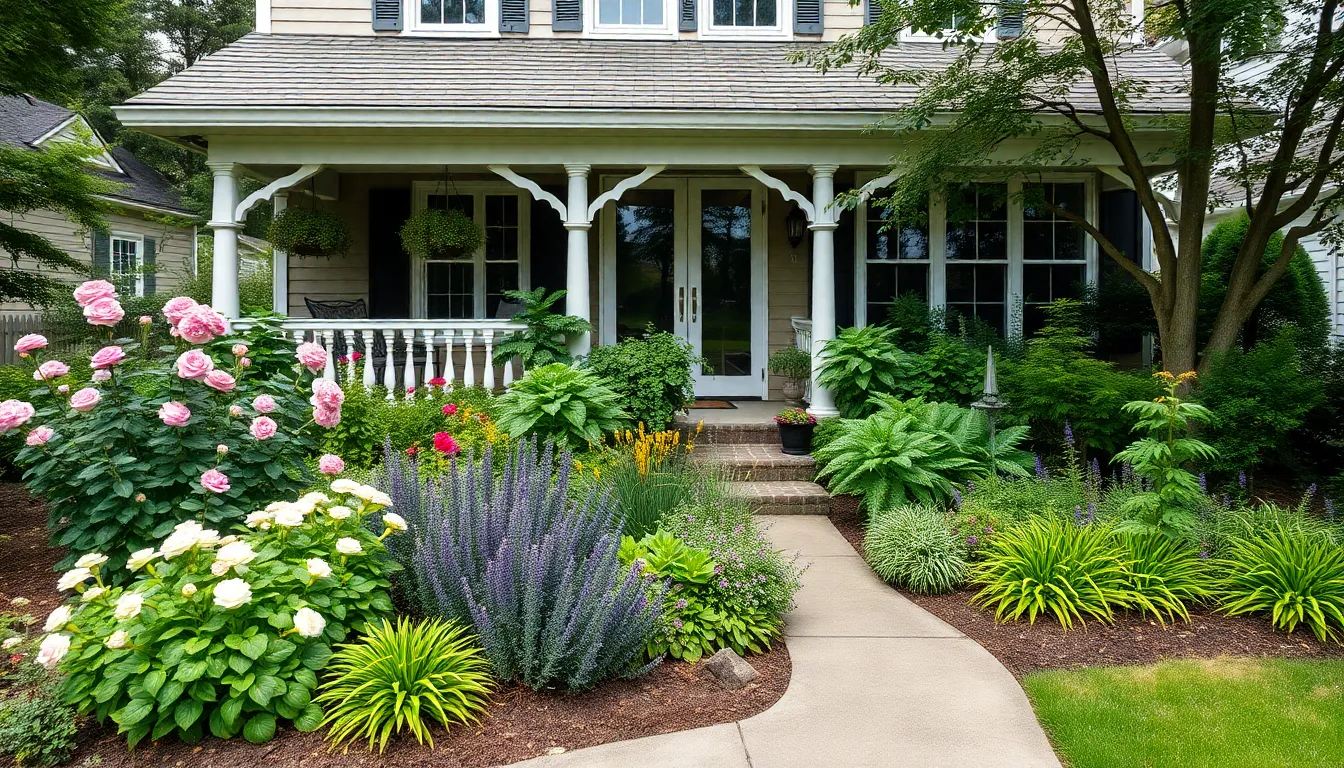
Before we jump into exact plant selections, understanding your site’s unique conditions ensures successful planting outcomes and long-term industry health.
Sunlight Requirements and Exposure Considerations
Assessing your front yard’s daily sunlight exposure determines which plants will thrive in your exact location. Full sun plants require at least 6 hours of direct sunlight daily and include popular options like roses, lavender, and ornamental grasses. Partial shade varieties flourish with 3-6 hours of sun exposure, making them perfect for areas with morning sun or filtered light throughout the day.
Shade tolerant plants grow successfully in locations receiving less than 3 hours of direct sunlight, such as hostas, ferns, and certain flowering shrubs. Understanding these light requirements before purchasing prevents costly mistakes and ensures your front yard plants establish properly. We recommend observing your front yard’s sun patterns throughout different seasons, as deciduous trees can significantly alter light conditions between summer and winter months.
Soil Conditions and Drainage Needs
Testing your soil’s texture and drainage capabilities guides plant selection toward species that naturally adapt to your site conditions. Moisture loving plants like astilbe and cardinal flower suit areas with consistent watering or natural moisture retention from downspouts or sloped terrain. Drought tolerant varieties such as sedum, ornamental grasses, and native wildflowers thrive in dry soil conditions and require minimal supplemental watering once established.
Clay soils retain moisture longer but may cause root rot in plants preferring well-drained conditions, while sandy soils drain quickly and benefit from plants adapted to drier environments. We suggest performing a simple drainage test by digging a hole and filling it with water to observe how quickly it drains. Plants matched to your soil’s natural drainage patterns establish faster and require less ongoing maintenance throughout their lifespan.
Mature Size and Spacing Guidelines
Planning for each plant’s mature dimensions prevents overcrowding and eliminates future transplanting needs. Small shade trees reaching less than 35 feet work well near homes without overwhelming the structure, while medium shade trees spanning 35-45 feet suit larger front yards with adequate space. Large shade trees exceeding 45 feet require careful placement away from power lines and structures to avoid future conflicts.
Proper spacing ensures adequate air circulation between plants, reducing disease risk and allowing each specimen to reach its full aesthetic potential. We recommend researching exact width measurements for shrubs and perennials, then spacing them according to their mature spread rather than their current nursery size. Foundation plantings should maintain at least 3-5 feet from your home’s exterior walls to prevent moisture issues and allow for proper growth without crowding windows or walkways.
Incorporate Functional Plants That Serve Multiple Purposes
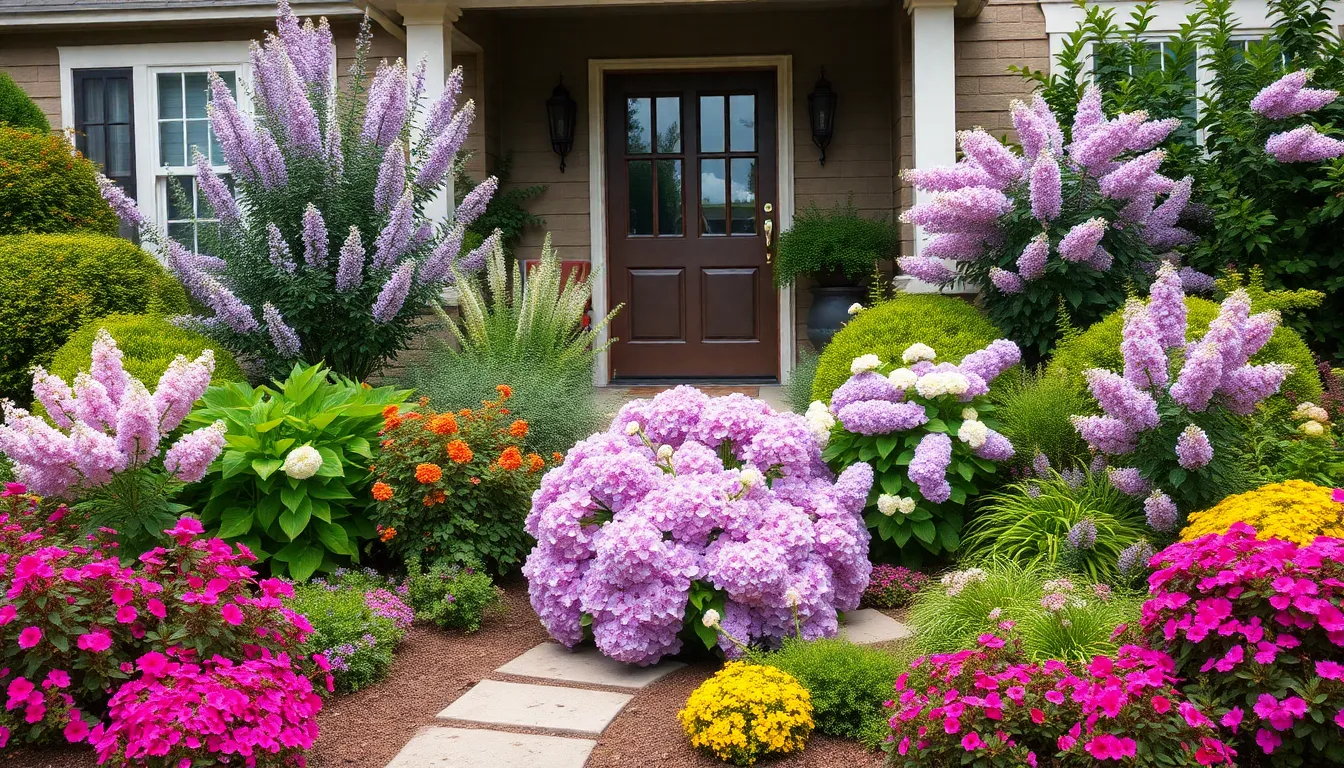
Maximizing our front yard’s potential means selecting plants that deliver multiple benefits beyond basic decoration. We can create landscapes that provide privacy, fragrance, and environmental support while maintaining visual appeal.
Privacy Screening Plants for Front Yards
Sky Pencil Holly serves as an excellent vertical screening solution with its slender, columnar evergreen structure that creates natural privacy barriers. This dense shrub maintains year-round greenery and requires only occasional pruning to keep its elegant upright form.
Spirea shrubs form effective screening hedges while delivering seasonal blooms that add color and texture to our front yard boundaries. These versatile plants grow quickly into dense barriers that block unwanted views while creating attractive focal points.
Weigela varieties provide dual functionality as privacy screens and colorful industry features with their abundant spring flowers and dense foliage. We can position these shrubs strategically to create natural boundaries that enhance rather than obstruct our home’s architectural appeal.
Fragrant Plants Near Entryways and Windows
Lilac shrubs produce abundant clusters of sweet-smelling purple flowers in mid-spring that create welcoming aromas near doorways and windows. These drought tolerant plants thrive in full or partial sun and establish quickly once planted in suitable locations.
Hydrangeas offer large, showy blooms in various colors that can be positioned as focal points near entryways for visual impact. While their fragrance remains subtle compared to lilacs, these plants provide substantial presence and seasonal interest around our home’s main access points.
Potentilla shrubs deliver vibrant flowers throughout the growing season while remaining low maintenance and deer resistant. We can plant these hardy specimens near windows and patios where their continuous blooms create lasting visual and aromatic appeal.
Pollinator-Friendly Plants for Environmental Benefits
Hardy geraniums like Geranium sanguineum offer extended blooming periods that provide consistent nectar sources for bees and butterflies. These perennials require minimal care while supporting local pollinator populations through multiple seasons of continuous flowers.
Flowering shrubs such as potentilla and hardy geraniums supply essential nectar and pollen that benefit diverse pollinator species throughout the growing season. We can incorporate these plants strategically to create pollinator pathways that connect our front yard to broader network networks.
Diverse flowering plant combinations ensure continuous bloom periods that sustain pollinator populations from early spring through late fall. This approach supports environmental health while creating ever-changing seasonal displays that enhance our property’s curb appeal and ecological value.
Design Plant Groupings for Maximum Curb Appeal Impact

Creating stunning plant groupings requires strategic placement that builds visual depth and maintains clear sight lines. We’ll explore how thoughtful arrangements, color coordination, and hardscape integration work together to maximize your home’s street appeal.
Color Coordination and Plant Combinations
Brightly colored flowering plants become powerful tools for highlighting entryways and drawing attention to your home’s best features. We recommend selecting complementary colors that enhance your home’s existing palette, such as matching vibrant flower colors to your shutters or creating harmony with your front door’s bold hue.
Plants with interesting foliage add unexpected texture and color beyond traditional blooms. Ornamental grasses bring movement and seasonal interest, while variegated or silver-toned leaves create striking contrasts that catch the eye throughout the growing season.
Small planting areas like mailbox gardens offer perfect opportunities to add concentrated bursts of color. These focused displays help tie your entire front yard design together, creating visual connections that make the industry feel intentional and polished.
Symmetrical vs. Asymmetrical Planting Arrangements
Symmetrical arrangements frame entryways and pathways with balanced, even plantings that create a formal, welcoming aesthetic. This approach works particularly well with traditional and classic home styles, where matching plantings on either side of the entrance establish a sense of order and elegance.
Asymmetrical arrangements embrace a more natural, relaxed approach that flows with your industry’s existing contours and hardscape elements. These ever-changing designs use varied plant heights and irregular groupings to create visual interest while maintaining an organic feel that complements modern and cottage-style homes.
Both approaches can achieve maximum curb appeal when executed thoughtfully. The key lies in understanding your home’s architectural style and choosing the arrangement that best complements its character while creating the atmosphere you want to convey.
Integration with Hardscape Elements
Hardscape features like pathways, gravel borders, pavers, and mulched garden beds define your planting areas while improving accessibility and visual structure. These elements create clear boundaries that help organize your plant groupings and make maintenance easier over time.
Arbors and trellises planted with climbing roses or other vertical plants create dramatic focal points at entrances. These structures add height and architectural interest while providing support for plants that might otherwise require staking or extensive pruning.
Clear pathways combined with low-maintenance plants that retain their form ensure your front yard remains both beautiful and functional. This approach keeps utility areas accessible while maintaining the visual appeal that makes guests feel welcome and creates lasting positive impressions.
Maintain Your Front House Plants for Long-Term Success
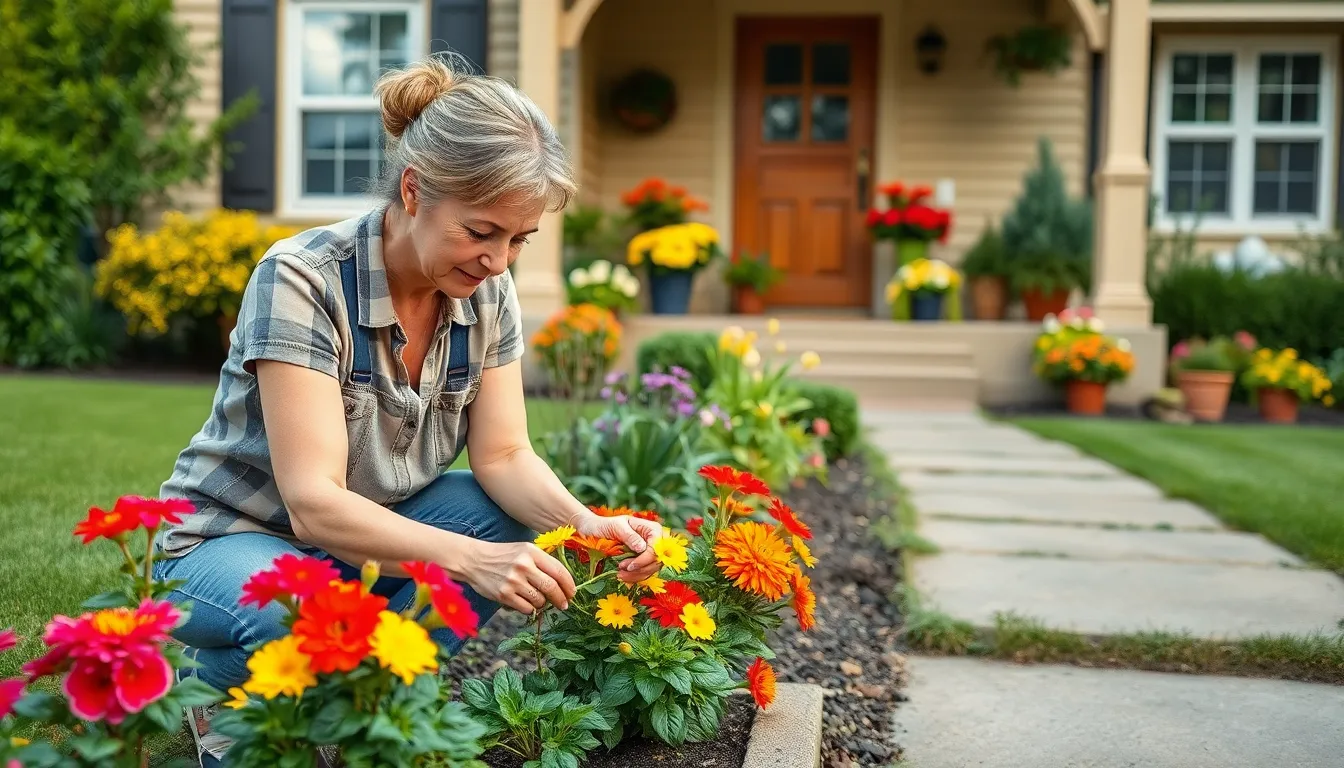
Creating a stunning front yard industry is just the beginning—maintaining these plants ensures they’ll continue improving your home’s curb appeal for years to come. Establishing consistent care routines and understanding your plants’ exact needs makes all the difference between thriving gardens and struggling landscapes.
Seasonal Care and Pruning Requirements
Plants require different care as seasons change, and understanding these needs helps us maintain healthy front yard displays year round. Pruning becomes essential during growing seasons when we snip off brown or dead leaves and trim overgrowth to encourage healthy development and prevent disease spread.
Spring maintenance focuses on removing winter damage and preparing plants for active growth. We inspect for broken branches, frost damage, and signs of pest activity that may have developed during dormancy.
Summer care involves regular deadheading of flowering plants and monitoring for heat stress signs. Watering schedules increase during hot months, especially for newly planted specimens still establishing their root systems.
Fall preparation includes final pruning sessions and cleanup of fallen leaves that could harbor diseases. We reduce watering frequency as plants enter dormancy and prepare for winter conditions.
Winter protection may require covering tender plants or moving containers to sheltered locations. Indoor or porch plants benefit from thorough cleaning sessions every few months, which helps flush soil salts and remove leaf dust that interferes with photosynthesis.
Watering and Fertilization Best Practices
Watering frequency depends entirely on plant type and environmental conditions, making it crucial to understand each species’ exact requirements. Tropical plants often need weekly watering sessions, while succulents and cacti prefer biweekly schedules or less frequent watering to prevent root rot development.
Soil selection plays a vital role in watering success—well-draining mixtures work best for succulents, while moisture-retentive soils benefit tropical species. We adjust our watering techniques based on these soil characteristics and monitor plants for signs of water stress.
Fertilization timing matters just as much as frequency, with balanced, slow-release plant food providing steady nutrients without overfeeding risks. Growing seasons like spring and summer require more frequent feeding, while fall and winter dormancy periods need reduced or eliminated fertilization.
Container plants may need more frequent watering and feeding than ground-planted specimens due to limited soil volume. We check soil moisture levels regularly and maintain consistent feeding schedules for optimal container plant health.
Common Problems and Answers
Overwatering leads to root rot and yellowing leaves, which we fix by reducing water frequency and improving drainage around affected plants. Signs include mushy stems, foul-smelling soil, and leaves that yellow from the bottom up.
Underwatering causes wilting and dry leaf tips, requiring us to water more frequently while monitoring soil moisture levels carefully. Plants showing these symptoms need gradual rehydration rather than sudden heavy watering sessions.
Pest infestations like aphids and spider mites can damage leaves and stunt growth throughout the growing season. Regular cleaning and pruning help prevent these issues, while mild insecticidal soaps provide treatment options when problems develop.
Insufficient light exposure causes stunted growth and poor flowering in sun-loving plants, which we address by relocating plants or supplementing with grow lights. Shade-tolerant varieties may need protection from excessive sun rather than additional light sources.
Nutrient deficiencies show up as poor growth, pale leaves, or reduced flowering, requiring soil testing and appropriate fertilizer applications. We establish weekly “plant days” for consistent monitoring and maintenance, keeping necessary tools and supplies readily available to address problems quickly.
Conclusion
We’ve covered everything you need to transform your front yard into a stunning industry that enhances your home’s curb appeal and value. From selecting the right foundation plants to creating seasonal interest and addressing common maintenance challenges your success depends on thoughtful planning and consistent care.
Remember that the best front yard plantings reflect both your personal style and your home’s architecture while working harmoniously with your local climate. By choosing plants that suit your exact conditions and committing to regular maintenance you’ll create an outdoor space that welcomes guests and brings you pride for years to come.
Start small with a few key plants and gradually build your front yard garden as you gain confidence and experience. Your investment in quality plants and proper care will reward you with a beautiful industry that stands out in your neighborhood.
Frequently Asked Questions
What are the best low-maintenance plants for front yard landscaping?
Evergreen shrubs like boxwoods and junipers are excellent choices for year-round appeal with minimal upkeep. Drought-tolerant perennials such as ornamental grasses, sedums, and lavender thrive in various conditions while attracting pollinators. Native plants are also ideal as they adapt well to local environments and require less maintenance than non-native varieties.
How do I choose plants that match my home’s architectural style?
Colonial homes benefit from structured plantings like boxwoods and formal flowering shrubs such as hydrangeas. Modern contemporary homes suit bold, architectural plants like agaves that emphasize clean lines. Mid-century modern styles work well with layered plantings and compact evergreens, while cottage-style homes embrace informal, lush plantings with mixed perennials and climbing vines.
What factors should I consider when selecting front yard plants?
Assess your yard’s sunlight exposure to determine whether you need full sun, partial shade, or shade-tolerant plants. Consider soil conditions and drainage requirements, choosing plants that naturally adapt to your specific environment. Also, plan for each plant’s mature size and ensure proper spacing to prevent overcrowding and promote healthy growth.
How can I create year-round color in my front yard?
Combine plants with different blooming seasons for continuous interest. Use early spring bloomers like forsythia and azaleas, summer performers like potentilla, and plants that provide fall and winter appeal such as evergreen shrubs and ornamental grasses. This layered approach ensures your landscape looks attractive throughout all seasons.
What’s the best way to create visual interest with plant heights?
Use a three-tier approach: tall backdrop plants like trees and large shrubs for privacy and vertical interest, medium-height focal point plants to draw attention and anchor the design, and low-growing ground cover to fill gaps and soften hardscape edges. This layered strategy creates depth and visual appeal.
How often should I water and fertilize my front yard plants?
Watering and fertilization needs vary by plant type and environmental conditions. Establish a consistent care routine based on each plant’s specific requirements. Generally, deep, less frequent watering is better than shallow, frequent watering. Monitor soil moisture and adjust based on weather conditions and seasonal changes.
What are common front yard plant problems and how do I solve them?
Common issues include overwatering, underwatering, pest infestations, insufficient light exposure, and nutrient deficiencies. Solutions involve adjusting watering schedules, relocating plants to appropriate light conditions, implementing pest control measures, and providing proper fertilization. Regular monitoring helps identify problems early for easier resolution.
When is the best time to prune my front yard plants?
Pruning timing depends on the plant type and blooming schedule. Spring-flowering shrubs should be pruned immediately after blooming, while summer bloomers can be pruned in late winter or early spring. Evergreens typically need minimal pruning but can be shaped in late spring. Always research specific pruning requirements for each plant variety.







